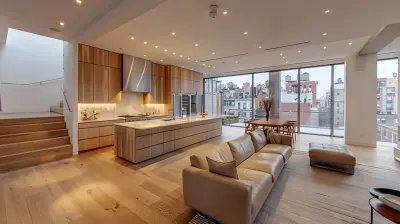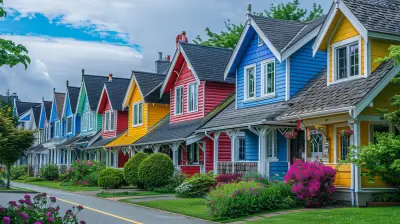Why Housing Markets in Smaller Cities Are Booming
27 October 2025
Let’s face it—real estate has always been a bit of a rollercoaster ride. But lately, there’s been a surprising twist in the story: smaller cities are stealing the spotlight. Once overlooked, these modest metros are now booming with active housing markets, buzzing developments, and rising property values. But why? What’s causing this shift from towering skyscrapers to cozy suburbs and mid-sized towns?
Grab your favorite mug of coffee (or wine, no judgment here), and let’s dive into why housing markets in smaller cities are booming—and why people like you and me are paying attention.
The Great Migration: Big City Burnout Is Real
Let’s start with the truth: big cities aren’t for everyone. Sure, there's a certain charm in the hustle, the late-night eateries, and the endless Instagrammable spots. But for many, the highs of urban living are increasingly outweighed by the lows—sky-high rent, relentless traffic, and the ever-looming pressure of “keeping up.”Then came the game-changer: remote work.
Suddenly, millions had the freedom to work from virtually anywhere. No longer shackled to the office downtown, folks started questioning the point of paying $3,000 a month for a 400-square-foot apartment when they could own a three-bedroom home in a smaller city for less. Makes sense, right?
Affordability: The Biggest Magnet of All
Let’s talk money—because, at the end of the day, it rules the real estate world.Big cities have long been associated with expensive everything—housing, groceries, parking, dog-sitting, you name it. Smaller cities, on the other hand, offer significantly more bang for your buck.
In cities like Boise, Idaho, or Fayetteville, Arkansas, buyers are discovering they can afford not just a home, but a lifestyle. Think backyards, community parks, and actual dining rooms instead of eating over your kitchen sink.
And it’s not just affordability in real estate. It’s the overall cost of living. Everything from auto insurance to your morning latte tends to be gentler on your wallet in smaller markets.
Quality of Life: It’s Not Just About Saving Money
Sure, saving money is nice. But how about shorter commutes, friendly neighbors, cleaner air, and an actual sense of community?Smaller cities often come with these built-in benefits. There’s a certain charm that’s hard to replicate in big-city living—the kind where you know your mailman by name or bump into friends at the local grocery store.
And let’s not forget about safety. Many smaller cities boast lower crime rates, making them ideal for families, retirees, and just about anyone craving peace of mind.
Hybrid Work Is Here to Stay
Remember when we all thought work-from-home would last a few weeks?Yeah. That seems like a lifetime ago.
The rise of hybrid work models has made it even more attractive to live outside the hustle and bustle of major metros. Now, you can enjoy the serene life in a smaller city and still hop on a Zoom call with your NYC or LA-based team—without ever having to sit through rush hour.
Some companies are even encouraging employees to relocate to lower-cost regions, especially as it helps them cut overhead. It’s a win-win: employers save money, and workers get more freedom and space.
Real Estate Investors Are Catching On
If you think it's just regular homebuyers shifting gears, think again. Real estate investors have their eyes on smaller cities too.Why? Because the returns are getting juicy.
In many secondary and tertiary markets, property prices are still relatively low, but demand is growing—meaning it's only a matter of time before values rise. Savvy investors are jumping in early, scooping up rental properties and watching their profits climb.
It’s that classic case of catching the wave before it crests. Investors chasing yield are realizing that smaller cities offer better cap rates, less competition, and more long-term potential.
Urban Sprawl and Infrastructure Improvements
You’ve heard the saying: “If you build it, they will come.”And come they did.
Thanks to growing infrastructure investment, many smaller cities are no longer cut off from the world. Better highways, improved public transport, and expanded airports have made these regions more accessible—and attractive.
Couple that with investments in schools, hospitals, and broadband internet, and suddenly, small-town living doesn’t feel so small anymore. It feels connected, convenient, and comfortable.
Gen Z and Millennials Are Shaping the Shift
Who’s driving all this demand for homes in smaller cities?The answer: younger generations.
Tired of living paycheck to paycheck in overpriced urban apartments, Millennials and Gen Z are seeking out cities where they can actually build a future. They’re buying homes, starting families, and opening businesses in places their parents might never have considered.
And guess what? These generations also prioritize work-life balance, mental health, and community ties—all things more easily found in smaller cities.
Tech and Startups Love Smaller Cities Too
Once upon a time, every tech startup aimed for Silicon Valley. But not anymore.Smaller cities across the U.S. and beyond are becoming mini tech hubs. Thanks to lower overhead, access to talent, and supportive business environments, entrepreneurs are planting their roots in cities like Tulsa, Salt Lake City, and Asheville.
This, in turn, creates jobs, boosts local economies, and—you guessed it—fuels the housing market.
Lifestyle Upgrades: Nature, Space, and Peace of Mind
Let’s not underestimate the value of wide open spaces.After spending months cooped up in 2020, many of us came to a big realization: fresh air and a little elbow room are non-negotiable. Smaller cities often come with proximity to hiking trails, rivers, lakes, or mountains. And instead of dodging taxis or weaving through crowds, you’re walking your dog in peace or biking to your local farmer’s market.
It’s not just a house—it’s a lifestyle shift. And more people are choosing quality of life over quantity of options.
Government Incentives Make It Easier
Believe it or not, some local governments are paying people to move.Yep—you heard that right.
From cash bonuses to tax breaks to student loan repayment assistance, several mid-sized and smaller cities are rolling out the red carpet to attract new residents and talent. For example, places like Tulsa, Oklahoma, have offered relocation grants to remote workers willing to make the move.
It’s a smart play that benefits everyone: newcomers get perks, and cities get an economic boost.
Rising Home Prices Everywhere Push Buyers Outward
It’s no secret that housing prices have been climbing across the board. But for many, prices in major cities have simply become unreachable.As prices soar in places like New York, San Francisco, and Seattle, buyers are forced to look elsewhere. And that “elsewhere” often points to smaller cities nearby—or even several states away—where they can still afford a decent home without maxing out their budget.
So, as demand increases and inventory tightens, smaller markets reap the rewards.
Builders and Developers Are Following the Trend
It’s not just buyers and investors on the move—builders and developers are too.Recognizing the shift in buyer behavior, many are redirecting efforts toward smaller cities. New housing developments, mixed-use communities, and even luxury townhomes are popping up in places that were considered too quiet just a few years ago.
It’s a classic case of supply meeting demand—and another reason these markets are booming.
Final Thoughts
So, why are housing markets in smaller cities booming?Because we’re rethinking what we want out of life. The shiny big city is still attractive, sure, but it’s no longer the only option. With remote work, affordability, and a craving for community, more people are making the jump—and they’re not looking back.
It’s a seismic shift in how we live, work, and invest. And while no one knows exactly what the future holds, one thing is clear: smaller cities are having a big moment.
If you’ve been on the fence about exploring life—or real estate investing—in a smaller city, now might just be the perfect time to lean in and see what the buzz is all about.
all images in this post were generated using AI tools
Category:
Housing MarketAuthor:

Kingston Estes
Discussion
rate this article
1 comments
Jackson Lozano
Smaller cities are emerging as vibrant hubs for growth and opportunity! With affordability, community charm, and unique lifestyle offerings, these markets are attracting new residents and investors alike. Embrace the shift—exploring these hidden gems can unlock incredible potential for both personal fulfillment and financial success. Exciting times ahead!
October 27, 2025 at 4:36 AM

Kingston Estes
Absolutely! Smaller cities indeed offer unique advantages that drive growth and attract both residents and investors. Their charm and affordability present exciting opportunities for personal and financial success. Embracing this trend is essential for those looking to thrive in today's evolving housing market.


